| Family: |
Cichlidae (Cichlids), subfamily: Pseudocrenilabrinae |
| Max. size: |
11.57 cm TL (male/unsexed) |
| Environment: |
benthopelagic; freshwater |
| Distribution: |
Africa: known only from the catchment of Lake Natron, Tanzania and Kenya (Ref. 2, 5166, 118638). |
| Diagnosis: |
Dorsal spines (total): 9-13; Dorsal soft rays (total): 11-15; Anal spines: 3-3; Anal soft rays: 9-11; Vertebrae: 27-30. Diagnosis: A small elongated species with a terminal mouth (Ref. 118638). Mature males have dark-edged dorsal and anal fins, iridescent blue-white spots on flanks, white lower lips, and a spotted caudal fin with a pink edge; they appear to be colour polymorphic, with some males having yellow bellies and throats, while others are blue white: both morphs can be found in the same location and the colours are stable in aquarium-held specimens, suggesting it is a true polymorphism and not related to reproductive state (Ref. 118638). Females and non-territorial males are sandy-coloured, pale ventrally, sometimes with faint vertical bars (Ref. 118638).
Description: Mature females with an overall golden hue; males with the flanks a pale blue and the lateral parts of the lower lip swollen and brilliant; in full color the blue spots on the scales become iridescent (Ref. 2). The genital papilla is conical, prominent and yellow in the mature male, less prominent, but swollen in the mature female (Ref. 2). Scale rows on cheeks 3-4 (Ref. 2). Preorbital bone with only 4 pores and no scales (Ref.4967). |
| Biology: |
Occurs at a temperature range of 30-32°C (Ref. 2). It feeds actively in the early morning; mainly on algae as well as copepods and dipterous larvae (Ref. 2). A maternal mouthbrooder: males excavate pits in the substrate in shallow water (Ref. 2, 118638). The species is occasionally caught as a food fish in its natural range; although it attains a small size, its tolerance of hostile environments may make it suitable for culture in high salinity environments; potential as an aquarium fish (Ref. 118638). Classed as endangered, due to its restricted distribution (Ref. 118638). |
| IUCN Red List Status: |
Endangered (EN); Date assessed: 31 January 2006 (B1ab(i,ii,iii)+2ab(i,ii,iii)) Ref. (130435)
|
| Threat to humans: |
harmless |
Source and more info: www.fishbase.org. For personal, classroom, and other internal use only. Not for publication.

